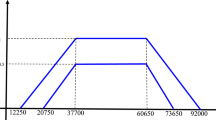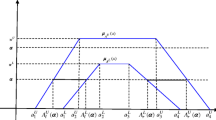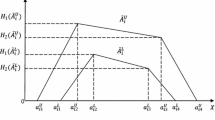Abstract
Transportation problems (TPs) play important roles in today’s highly competitive world. To maximize profits, organizations are always aiming for more revenue. In this chapter, we present the selecting fuzzy-zero method (SFZM), which can help us to find the optimal solution for minimizing transportation costs while maximizing profit. We present this SFZM to solve a fuzzy transportation problem (FTP), in which demand, supply, and transportation costs (TCs) are trapezoidal fuzzy numbers (TFNs). By using the existing solution methods, we convert these TFNs to fixed values and thus solve the FTP. We also compare the methods of (Hamdy AT. Operations research: an introduction, 8th edn. Pearson Prentice Hall, Upper Saddle River, 2007; Pandian P, Natarajan G. A. Appl Math Sci 4:79–90, 2010; Reinfeld NV, Vogel WR. Mathematical programming. Englewood Cliffs, Prentice-Hall, 1958; Souhail Dhouib. Int J Oper Res Inf Syst 12:1-16, 2022.) with our SFZM. We illustrate how the SFZM works by laying out numerical examples with a working procedure.
Access provided by Autonomous University of Puebla. Download conference paper PDF
Similar content being viewed by others
Keywords
1 Introduction
In today’s highly competitive global market, transportation models can maximize profit and minimize costs. Transportation problems (TPs) involve the transportation of items from different origins to different destinations. The classical TP developed by Hitchcock [9] and the transportation costs (TCs), demand, and supply are fixed numbers.
In real-life situations, fixed numbers do not come about naturally. In uncertain environments, Zimmermann [19] elevates a TP to a new model, which he labels as a fuzzy transportation problem (FTP). One FTP was formulated on the basis of the integer–value problem of Chanas and Kuchta [3]. Bellman and Zadeh [18] also aimed to solve FTPs with their technique. Pandian and Natarajan [12] aimed to find the optimal solution to the TCs, demand, and supply, which first requires using trapezoidal fuzzy numbers (TFNs). The optimal solution to any problem depends on the design function.
In the literature, a few initial basic feasible solutions are available, including the northwest corner method (NWCM) [10], the least cost method (LCM) [10], Vogel’s approximation method (VAM) [13], Goyal’s version of VAM (GVAM) [8], and the initial basic feasible solution (IBFS) proposed to the TP [1, 4, 5]. Also, many researchers have modified VAM to obtain an IBFS to the TP. In general, TPs are solved in fixed environments, but fixed environments do not appear in nature.
In the literature [6, 7, 11, 14,15,16,17], TFNs have been converted into fixed values, and researchers have used the robust ranking technique to solve FTPs. In this chapter, a TFN is converted into a fixed number by using the median method of ranking functions to solve FTPs. In this chapter, we present an SFZM and achieve the optimal solution. Our latest results are then compared with those from [10, 12,13,14].
2 Groundwork
In this section, we present a basic definition of TFN and a basic definition of the median ranking method.
2.1 Definition [12]
A fuzzy set \( \overset{\sim }{\rho } \) serves as a fuzzy number whose membership function has the following characteristics:
-
\( {\nu}_{\overset{\sim }{\rho }}\left(\zeta \right):= \rho \to \left[0,1\right] \) is continuous.
-
\( {\nu}_{\overset{\sim }{\rho }}\left(\zeta \right)=0\ \textrm{for}\ \textrm{all}\ \zeta \in \left(-\infty, {\zeta}_1\right]\cup \left[{\zeta}_4,\infty \right). \)
-
\( {\nu}_{\overset{\sim }{\rho }}\left(\zeta \right)\ is\stackrel{\longrightarrow}{\leftarrow} \textrm{strictly}\ \textrm{increasing}\ \textrm{for}\ \left[{\zeta}_1,{\zeta}_2\right]\ \textrm{and}\ \textrm{strictly}\ \textrm{decreasing}\ \textrm{for}\ \left[{\zeta}_3,{\zeta}_4\right]. \)
-
\( {\nu}_{\overset{\sim }{\rho }}\left(\zeta \right)=01\ \textrm{for}\ \textrm{all}\ \zeta \in \left[{\zeta}_2,{\zeta}_3\right],\textrm{where}\ {\zeta}_1<{\zeta}_2<{\zeta}_3<{\zeta}_4. \)
2.2 Definition [12]
A fuzzy number, \( \overset{\sim }{\rho }=\left({\zeta}_1,{\zeta}_2,{\zeta}_3,{\zeta}_4\right) \), is a TFN if its membership function is given by the following:
2.3 Ranking Function [2]
Let \( \overset{\sim }{\rho }=\left({\zeta}_1,{\zeta}_2,{\zeta}_3,{\zeta}_4\right) \) be the TFN, in which case the median ranking method yields \( \mathfrak{R}\left(\overset{\sim }{\rho}\right)=\left(\frac{\zeta_2+{\zeta}_3}{2}\right) \)
3 Proposed Algorithm
In this section, the steps for the SFZM are presented, as follows:
Step 1.
-
An unbalanced FTP refers to a balanced FTP that has zero fuzzy costs (ZFCs), adding minimum fuzzy cost.
Step 2.
-
The total supply ≠ the total demand, so ZFCs are added.
Step 3.
-
3(a) Select the lowest fuzzy cost (FC) value in each row, and then remove that from the FC values in that row.
-
3(b) Select the lowest FC value in each column, and then remove that from the FC values in that column. At minimum, one ZFC should now be available in each row and each column.
-
Step 4.
-
4(a) Confirm that the total fuzzy supply is lower than or equal to the total fuzzy demand.
-
4(b) Confirm that the total fuzzy demand is now lower than or equal to the total fuzzy supply.
-
4(c) If Step 4(a) and Step 4(b) have been completed, then jump ahead to Step 7; otherwise, proceed to Step 5.
Step 5.
-
The lowest-level lines are drawn parallel and perpendicular to the ZFCs in Step 3.
Step 6.
-
6(a) Starting from any cell not enclosed by lines, select the lowest FC.
-
6(b) Remove each FC in a cell not enclosed by lines.
-
6(c) Add to each (FC) in a cell enclosed by two lines.
-
6(d) If an FC in a cell enclosed by lines remains unchanged, then return to Step 4.
Step 7.
-
7(a) Select the lowest fuzzy TC value from Step 4.
-
7(b) Select a row single fuzzy-zero cell (RSFZC) and a column single fuzzy-zero cell (CSFZC) for allocation.
-
7(c) Allocate the maximum possible, and cross off in the usual manner.
-
7(d) If an RSFZC or a CSFZC does not appear in both rows and columns, then repeat the process from Step 7(a) to Step 7(c) until this requirement has been satisfied.
4 Numerical Examples
4.1 Fuzzy Data for Example 1 [12, 14] (Table 1)
The chosen fuzzy data for Example 1 are balanced. We used the median ranking method for the defuzzification process (Tables 2 and 3).
The minimum TC value according to the NWCM fixed cost is ₹138.5 (Table 4).
The minimum TC value according to the LCM fixed cost is ₹134.5 (Table 5).
The minimum TC value according to VAM’s fixed cost is ₹123.5 (Table 6).
The minimum TC value according to the modified distribution method’s fixed cost is ₹121 (Table 7).
The minimum TC value according to the SFZM’s fixed cost is ₹121.
4.2 SFZM with [10, 12,13,14]
According to a comparison of the SFZM with the methods from [10, 12,13,14], as shown in Table 8, SFZM clearly provides lowest cost and thus the optimal result (Table 9; Figs. 1 and 2).
4.3 Fuzzy Data for Example 2 [14] (Tables 10, 11 and 12; Figs. 3 and 4)
4.4 Merits of Using the SFZM
In this chapter, the SFZM converted TFNs into fixed numbers, and we compared our results with those from [10, 12,13,14], which shows that the SFZM offers better solutions than those offered in [10, 12,13,14]. The SFZM also has the following merits:
5 Conclusion
In this chapter, the SFZM used the mean ranking method to convert the TFNs of transportation problems into fixed numbers.
-
For the total cost of Example 1, the results of the SFZM solution, in Table 8, show that value to be ₹121, which is better than the cost of [12] and that of [14], which were ₹132.17 and ₹122.5, respectively.
-
For the total cost of Example 2, the results of the SFZM solution, in Table 11, show that value to be ₹560, which is better than the cost of [14], which was ₹577.5.
References
Akpana, T., Ugbeb, J.U., Ajahd, O.: A modified Vogel approximation method for solving balanced transportation problems. Am. Sci. Res. J. Eng. Technol. Sci. 14, 289–302 (2015)
Ashale, T.R.: Newly Proposed Matrix Reduction Technique under Mean Ranking Method for Solving Trapezoidal Fuzzy Transportation Problems Under Fuzzy Environment (2021). https://doi.org/10.20944/preprints202106.0573
Charnes, A., Cooper, W.W., Henderson, A.: An Introduction to Linear Programming. Wiley, New York (1953)
Deshmukh, N.M.: An innovative method for solving transportation problem. Int. J. Phys. Math. Sci. 2, 86–91 (2012)
Ekanayake, E.M.U.S.B., Perera, S.P.C., Daundasekara, W.B., Juman, Z.A.M.S.: A modified ant colony optimization algorithm for solving a transportation problem. J. Adv. Math. Comput. Sci. 35, 83–101 (2020)
Fegade, M.R., Jadhav, V.A., Muley, A.A.: Solving Fuzzy transportation problem using zero suffix and robust ranking methodology. IOSR J. Eng. 2, 36–39 (2012)
Allung, F.M., Blegur, N.K.F., Dethan.: Modified Hungarian method for solving balanced fuzzy transportation problems. J. Varian. 5, 161–170 (2022)
Goyal, S.K.: Improving VAM for unbalanced transportation problems. J. Oper. Res. Soc. 35, 1113–1114 (1984)
Hitchcock, F.L.: The distribution of a product from several sources to numerous localities. J. Phys. Sci. 20, 224–230 (1941)
Hamdy, A.T.: Operations Research: An Introduction, 8th edn, p. 2007. Pearson Prentice Hall, Upper Saddle River (2007)
Karthy, T., Ganesan, K.: Revised improved zero point method for the trapezoidal fuzzy transportation problems. AIP Conference Proceedings. (2019)
Pandian, P., Natarajan, G.: A new algorithm for finding a fuzzy optimal solution for fuzzy transportation problems. Appl. Math. Sci. 4, 79–90 (2010)
Reinfeld, N.V., Vogel, W.R.: Mathematical Programming. Prentice-Hall, Englewood Cliffs, NJ (1958)
Dhouib, S.: Solving the trapezoidal fuzzy transportation problems via new heuristic: The Dhouib-Matrix-TP1. Int. J. Oper. Res. Inf. Syst. 12, 1–16 (2022)
Soomro, A.S., Junaid, M., Tularam, G.A.: Modified Vogel’s approximation method for solving transportation problems. Math. Theory Model. 5 (2015)
Ngastiti, P.T.B., Bayu Surarso, S.: Zero point and zero suffix methods with robust ranking for solving fully fuzzy transportation problems. IOP Conference Series: Journal of Physics: Conference Series. (2018)
Ngastiti, P.T.B., Surarso, B., Sutimin.: Comparison between zero point and zero suffix methods in fuzzy transportation problems. J. Mat. Mantik. 6, 38–46 (2020)
Zadeh, L.A.: Fuzzy sets as a basis for a theory of possibility. Fuzzy Sets Syst. 1, 3–28 (1978)
Zimmermann, H.J.: Fuzzy programming and linear programming with several objective functions. Fuzzy Sets Syst. 1, 45–55 (1978)
Author information
Authors and Affiliations
Editor information
Editors and Affiliations
Rights and permissions
Copyright information
© 2024 The Author(s), under exclusive license to Springer Nature Switzerland AG
About this paper
Cite this paper
Boobalan, J., Raja, P. (2024). Optimal Solution for Transportation Problems Using Trapezoidal Fuzzy Numbers. In: Kamalov, F., Sivaraj, R., Leung, HH. (eds) Advances in Mathematical Modeling and Scientific Computing. ICRDM 2022. Trends in Mathematics. Birkhäuser, Cham. https://doi.org/10.1007/978-3-031-41420-6_51
Download citation
DOI: https://doi.org/10.1007/978-3-031-41420-6_51
Published:
Publisher Name: Birkhäuser, Cham
Print ISBN: 978-3-031-41419-0
Online ISBN: 978-3-031-41420-6
eBook Packages: Mathematics and StatisticsMathematics and Statistics (R0)








